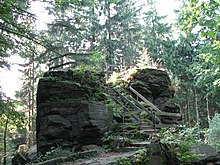Calf stones
| Calf stones | ||
|---|---|---|
|
View of the calf stones |
||
| height | 487 m | |
| location | Free State of Saxony , Germany | |
| Mountains | Lusatian highlands | |
| Coordinates | 51 ° 4 '22 " N , 14 ° 27' 11" E | |
|
|
||
| rock | Granodiorite | |
The Kälbersteine (also Kälberstein , Sorbian Chołmy ) are a mountain in the Bautzen district in Saxony .
Location and surroundings
They are located 1 km south of Crostau and about 3 km east of Schirgiswalde and belong to the Lausitzer Bergland .
geography
The mountain summit rises 205 m above the valley floor of the Spree valley from Schirgiswalde. The calf stone area has a great deal of rainfall, as evidenced by many springs and rivulets, some of which were used to supply water to the surrounding areas. Small, lush forest swamp communities can be found on these.
On the summit there is a small rock massif made of granodiorite, which has a summit book for around 10 possible sport climbing routes on the Kälberstein. There is also a Deutsche Post transmitter mast on the summit. The forest of the Kälberstein is characterized by spruce forest. Little has been preserved of the former Hercynian mixed mountain forest. Red beech, sycamore maple and English oak emerge only occasionally.
Origin of the name
According to tradition, the name of the mountain came about during the Thirty Years' War . At that time, the farmers of the area drove their cattle up this mountain to find protection and refuge here. On the other hand, Theodor Schütze says : “The name can hardly have anything to do with calves that are said to have been hidden in the mountain forest during the Thirty Years War.” Kelerstein is recorded on the map of the Scultetus from 1593 . In a loan from 1669 one speaks of a "Hichtwald" .
Say
A hiking legend relates to the wolf pits, which were also created here around 300 years ago. It is said locally that a farmer's wife who fell into a pit in which a wolf had already been caught, defended herself courageously with blows with her flax breaker until a hunter came along and finally killed the wolf.
A legend is also linked to the “Mordstein” on the way from Ellersdorf to Crostau. In the famine year 1772, a baker from Crostau is said to have killed a poor weaver from Ellersdorf at this point. The baker wanted to regain possession of a little sack of flour that he had previously sold to the weaver.
Solar phenomenon
In 2008, the public and school observatory "Bruno-H.-Bürgel" in Sohland / Spree, Department of Archaeoastronomy, examined a solar phenomenon on the summit rock of the Kälberstein Mountain. The sun shines on the equinoxes and the solstices through special viewing openings. Possibly the rock represents a prehistoric solar sanctuary. The archaeoastronomical research project was called "Project Gods Hand " and the rock objects that show the calendar solar observation phenomenon are referred to as " Sun sanctuaries of Upper Lusatia ". Information boards have been providing information on the archaeo-astronomical considerations on site since 2014. The summit rock with its calendar solar observation phenomenon is part of the "Sun Paths " tourism project . A joint project of the community of Sohland and the association of the public and school observatory "Bruno-H.-Bürgel" Sohland / Spree eV as part of the archaeoastronomical research project Götterhand.
literature
- Around Bautzen and Schirgiswalde (= values of the German homeland . Volume 12). 1st edition. Akademie Verlag, Berlin 1967, pp. 193–195.
- Ralf Herold: The track of light - project of the gods - sun sanctuaries of Upper Lusatia. Sohland / Spree observatory, Books on Demand, Norderstedt 2020, ISBN 978-3-7519-5892-9
Individual evidence
- ↑ Climbing areas in Upper Lusatia. (No longer available online.) Archived from the original on February 28, 2014 ; Retrieved June 19, 2014 . Info: The archive link was inserted automatically and has not yet been checked. Please check the original and archive link according to the instructions and then remove this notice.
- ↑ Infopack 2011, "Sun sanctuaries of Upper Lusatia", observatory "Bruno-H.-Bürgel" Sohalnd / Spree; Ralf Herold, "Sun Sanctuaries of Upper Lusatia - The money cellar on the Löbauer Berg and its real treasure", Oberlausitzer Verlag, 2012; Sohland Observatory, brochure "Archaeoastronomy", 2015



